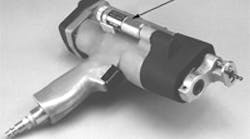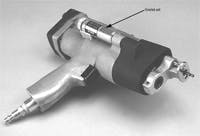Handheld and automated tools often use air motors for rotary power. That’s because air motors are smaller, lighter, and cooler running than their electromechanical counterparts. In repetitive drilling applications, compressed air often is not the best choice for feed drives. That’s because the slow feed rates usually required can cause stick-slip operation causing i rregular feed speeds. Consequently, many conventional drills used in repetitive drilling operations use a hydraul ic system to control the feed rate.
The hydraulic components of the feed mechanism normally are attached to the drill itself, adding to its weight and making it more difficult to manipulate. Other configurations use a hydraulic system separate from the drill and connected via hose, but this limits the drill’s portability. In either case improper or a lack of maintenance could cause leaks to occur, and if air gets into the hydraulic system, wide fluctuations in the drill feed rate could occur. HS Tooling Corp., Gardena, Calif., found a better solution to controlling feed rate of their air drills by integrating a Mini K Kinechek hydraulic speed regulator, from Deschner Corp., Santa Ana, Calif., into their design. The result is a portable, lightweight, and compact drill.
The Kinechek enables the air tool to drill with a steady feed rate, and its hermetically sealed, leakproof design requires no maintenance. The overall efficiency of drilling operations is also improved by Mini K’s ability to easily change the feed rate to suit various hole diameters and type of material being drilled simply by turning a built-in adjustment knob.
The Nutplate Drillmotor NPDM II-B from HS Tooling is used extensively in the aerospace industry. The drill may be held by one hand to locate, drill, and countersink rivet holes in a single 4-sec operation. The tool is easily converted from one rivet hole spacing to another by interchanging the foot attachments and spindle spacing block.
Air feed drills with an easily adjustable speed regulator offer a simple-to-operate solution for repetitive small hole drilling operations with less operator fatigue.
For more information, call Deschner Corp., (714) 557-1261, e-mail [email protected], or visit www.deschner. com. For more information on HS Tooling Corp., visit www.hstooling.com


